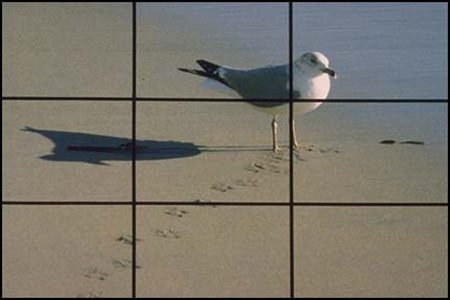In our Judeo-Christian society, we are used to hearing about the 10 Commandments. Drummed into us at an early age. However, in the photographic society, add one and make that 11 Commandments.
Despite the advent of new technologies that we now take for granted, such as auto-exposure and ‘instant’ review of shots, the practice of photography remains the same. Follow the ‘rules’ and you will find your ratio of good images to bad images will improve. Over the years, I have been asked many times to give out the “secrets” you learn in the professional photography arena. They are all here, just keep reading. I should add that all these tips come from real life experiences. None of it is made up.
 Rule of Thirds.
Rule of Thirds.
Tip number 1. Incredibly basic, but it is simply to read the manual. Read the manual again. In the case of digital cameras, read the manual again. You cannot do it too often. With digitals, you can see the effect immediately. When all else fails – read the manual again.
Tip number 2. Always carry one more memory stick than you think you’ll need when on holidays. The shot of a lifetime will appear and you will have already filled your memory stick. When you are digital, you haven’t got the time to sit there going ‘review-delete-review-delete’ with your digital SLR.
Tip number 3. Frequently check the exposure controls on your camera, that they really are set on Auto, or Shutter priority or what your standard setting is. It is very easy to knock the controls and settings when taking the camera in and out of the bag, or even when it has been hanging round your neck.
Tip number 4. When you get the CD with the images, immediately write on them the subject material of the shots and the date. Do this with black permanent texta pen so it doesn’t rub off and you will have saved yourself hours of frustration, flicking through hundreds of CDs, while looking for “Songkran 2011”. Once again, very basic, but very necessary.
Tip number 5. When going on holidays with your camera, take spare batteries with you – always. No matter how new the batteries, if there is a failure while you are trekking in Mongolia, or just lazing on the beaches in Koh Samet you will not be able to get the correct replacement. Remember also that your camera may use more than one type of battery, another trap for young players. Keep spares of both kinds.
Tip number 6. I mentioned this next one a couple of weeks ago. Always check that the camera neck strap is indeed tight and secure on both ends. If one end lets go, the camera will hit the ground before you have time enough to react. Cameras do not bounce well, if at all.
Tip number 7. Never keep your camera in the glove box of your car. With the temperatures that can be reached in the cubby hole reaching as high as 50 plus degrees Celsius in our blazing summers. The newer “plastic” bodied cameras and camera backs can actually warp with the high temperature.
Tip number 8. When you decide that you want an enlargement made of one particular shot, arrange for it straight away, while you still have the CD or memory stick handy, and before it gets covered in dust, damaged and scratched, making it impossible to get a decent enlargement, and before it gets lost, even though you have written on it what the CD is about (see Tip number 4).
Tip number 9. Always put spare memory sticks or cards back in their plastic containers, and keep them in the camera bag. I even suggest you tie them in place, so they don’t get lost. When you need it in a hurry, it has to be accessible. It will happen, believe me.
Tip number 10. When shooting kids or animals for doting parents/owners, get down to the subject’s level. You’ll get a better shot!
Tip number 11. Remember the Rule of Thirds. Place the subject one third in from one side and one third down from the top edge for photos that appeal.
Now that was simple, wasn’t it. Now go and apply them.




